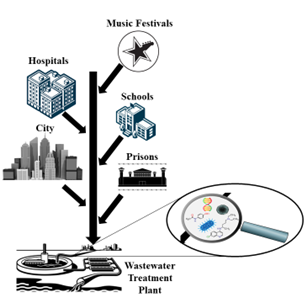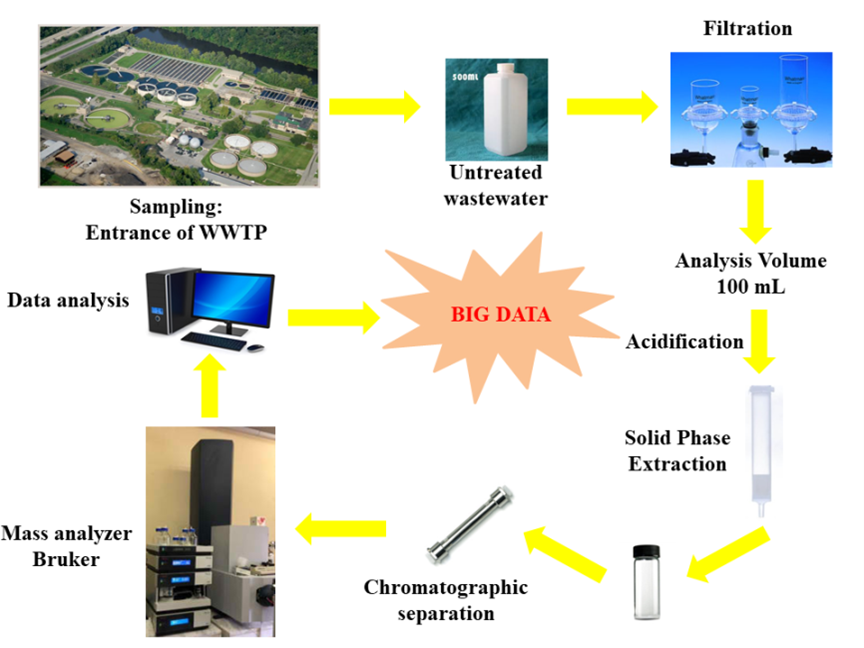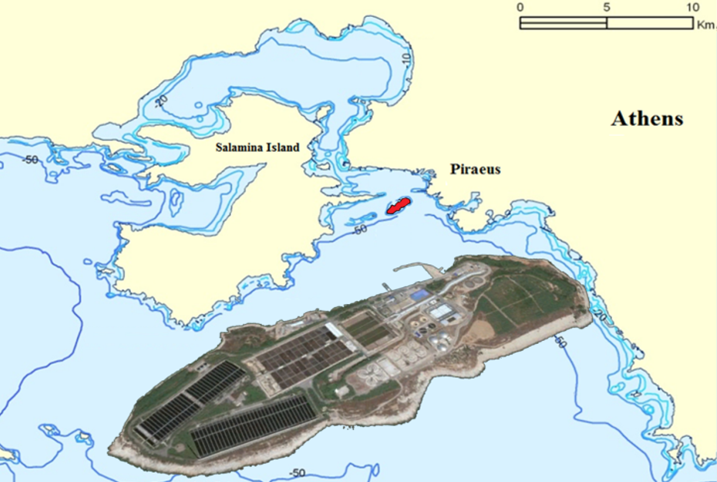Wastewater-Based Epidemiology
Wastewater-Based Epidemiology (WBE) is a novel approach for the retrieval of epidemiological information from untreated wastewater through the analysis of specific human metabolic excretion products (biomarkers). WBE consists in the chemical analysis of the wastewater produced by a population and sampled at the inlet of a wastewater treatment plant (WWTP). It can be described as a collective urine test, as the wastewater from a city pools the anonymous urine samples of thousands of individuals. WBE approach is based on the known principle that traces of almost everything entering the human body is metabolized and excreted with urine and/or stool, either unchanged or as metabolites, into the sewage system. The amount of a specific biomarker measured in untreated wastewater reflects the amount of the parent compound consumed by the population served by the plant (Figure 1). Therefore, monitoring wastewater has the potential to extract useful epidemiological information related to human habits, human exposure to environmental and food toxicants and health and illness status within a population.

Figure 1. Analysis of untreated wastewater can provide information on substances directly or indirectly ingested by a population of a city.
Initially, WBE was applied only for research reasons, but recently has attracted the attention of public authorities and international organizations. The European Monitoring Centre for Drugs and Drug Addiction (EMCDDA) has added WBE as a complementary evidence tool to the conventional indicators on drug use. The National Wastewater Drug Monitoring Program conducted by the analytical research teams at the University of South Australia and the University of Queensland, has as an aim to inform the public and the Australian Criminal Intelligence Commission (ACIC) on illicit drug trends, opioids, nicotine and alcohol consumption across Australia. The Greek National Public Health Organization integrated WBE to the common clinical tests in order to track all symptomatic and asymptomatic people infected by SARS-CoV-2 (COVID-19 pandemic) and evaluate the effectiveness of the taken measures.
Analysis of untreated wastewater offers many advantages, such as:
- objective and near real time information can be obtained, at reduced complexity compared to other methodologies;
- rapid identification of any increase and/or decrease of particular compounds;
- assessment of the effectiveness of preventive programs;
- very low ethical risks;
- identification of illicit direct disposals of chemicals into the sewage system;
- monitoring pandemics (i.e. COVID-19) and the effectiveness of the taken measures at reduced time.
Generally, a WWTP can be considered as the public “body” of a specific population and the combination of information obtained through wastewater analysis with other epidemiological and demographic data can be used to monitor the health status of a population.
Analytical Methodology
Analytical chemistry is the strong base of the WBE approach. Quantification of WBE biomarkers in untreated wastewater is performed with advanced analytical instruments that are able to detect simultaneously different compounds with high specificity and selectivity. The analytical procedure includes multiple steps (Figure 2).

Figure 2. Main steps of the analytical methodology.
The laboratory of Analytical Chemistry of the National and Kapodistrian University of Athens collects samples from the WWTP of Athens (Psyttaleia), since 2010 (Figure 3).

Figure 3. The WWTP of Athens is located in the island of Psyttaleia and it is the largest of Greece and one of the largest in the world.
Initially, samples are filtered, since wastewater contains a high amount both of organic material and solid particles that could cause many problems during the subsequent analysis steps. Then samples are acidified and extracted using Solid Phase Extraction, which is the most powerful tool for the isolation and purification of the compounds. Chemical analysis is performed using advanced high resolution mass spectrometry (HRMS) techniques and data processing uses three approaches (target analysis, suspect screening and non-target screening) to extract information for a wide range of compounds. Finally, the obtained Big Data are used for the application of the WBE approach on the population of Athens.
Scientific Projects
The innovative wastewater-based epidemiology approach with the advances of high resolution mass spectrometry as a complementary biomonitoring tool for assessing the health status of a population NTS-EXPOSURE
Sewage Analysis CORe group Europe (SCORE)
SCORE COST (European Cooperation in Science and Technology) Action ES1307 is supported by the EU Framework Programme Horizon 2020.
Publications
Investigation of Biotransformation Products of p-Methoxymethylamphetamine and Dihydromephedrone in Wastewater by High-Resolution Mass Spectrometry. J. Kinyua, A.K. Psoma, N.I. Rousis, A. Covaci, A. van Nuijs and Ν.S. Τhomaidis, Metabolites, 2021, 11, 66 (doi.org/10.3390/metabo11020066) https://www.mdpi.com/2218-1989/11/2/66
Analytical methodologies for the detection of SARS-CoV-2 in wastewater: Protocols and future perspectives. N. Alygizakis, A.N. Markou, N.I. Rousis, A. Galani, M. Avgeris, P.G. Adamopoulos, A. Scorilas, E.S. Lianidou, D. Paraskevis, S. Tsiodras, A. Tsakris, M.A. Dimopoulos and N.S.Thomaidis, Trends in Analytical Chemistry, 2021, 134, 116125 (doi.org/10.1016/j.trac.2020.116125) https://www.sciencedirect.com/science/article/pii/S016599362030354X#!
Wide-scope target screening of >2000 emerging contaminants in wastewater samples with UPLC-Q-ToF-HRMS/MS and smart evaluation of its performance through the validation of 195 selected representative analytes. P. Gago-Ferrero, A.A. Bletsou, D.E. Damalas, R. Aalizadeh, N.A. Alygizakis, H.P. Singer, J. Hollender and N.S.Thomaidis, Journal of Hazardous Materials, 2020, 387, 5, 121712 (doi.org/10.1016/j.jhazmat.2019.121712) https://www.sciencedirect.com/science/article/pii/S0304389419316668
Spatio-temporal assessment of illicit drug use at large scale: evidence from 7 years of international wastewater monitoring. I. González‐Mariño, J.A. Baz‐Lomba, N.A. Alygizakis, M.J. Andrés‐Costa, R. Bade, A. Bannwarth, L.P. Barron, F. Been, L. Benaglia, J‐D. Berset, L. Bijlsma, I. Bodík, A. Brenner, A.L. Brock, D.A. Burgard, E. Castrignanò, A. Celma, C.E. Christophoridis, A. Covaci, O. Delémont, P. de Voogt, D.A. Devault, M.J. Dias, E. Emke, P. Esseiva, D. Fatta‐Kassinos, G. Fedorova, K. Fytianos, C. Gerber, R. Grabic, E. Gracia‐Lor, S. Grüner, T. Gunnar, E. Hapeshi, E. Heath, B. Helm, F. Hernández, A. Kankaanpaa, S. Karolak, B. Kasprzyk‐Hordern, I. Krizman‐Matasic, F.Y. Lai, W. Lechowicz, A. Lopes, M. López de Alda, E. López‐García, A.S.C. Löve, N. Mastroianni, G.L. McEneff, R. Montes, K. Munro, T. Nefau, H. Oberacher, J. O’Brien, R. Oertel, K. Olafsdottir, Y. Picó, B.G. Plósz, F. Polesel, C. Postigo, J.B. Quintana, P. Ramin, M.J. Reid, J. Rice, R. Rodil, N. Salgueiro‐González, S. Schubert, I. Senta, S.M. Simões, M.M. Sremacki, K. Styszko, S. Terzic, N.S. Thomaidis, K.V. Thomas, B.J. Tscharke, R. Udrisard, A.L.N. van Nuijs, V. Yargeau, E. Zuccato, S. Castiglioni, and C. Ort, Addiction, 2019, 115, 109-120 (doi.org/10.1111/add.14767) https://onlinelibrary.wiley.com/doi/full/10.1111/add.14767
Wide-scope target and suspect screening methodologies to investigate the occurrence of new psychoactive substances in influent wastewater from Athens. K. Diamanti, R. Aalizadeh, N. Alygizakis, A. Galani, M. Mardal, N.S.Thomaidis, Science of The Total Environment, 2019, 685, 1, 1058-1065 (doi.org/10.1016/j.scitotenv.2019.06.173) https://www.sciencedirect.com/science/article/pii/S0048969719327445
HighResNPS.com: An Online Crowd-Sourced HR-MS Database for Suspect and Non-targeted Screening of New Psychoactive Substances M. Mardal, M.F. Andreasen, C. Brinch Mollerup, P. Stockham, R. Telving, N.S. Thomaidis, K.S. Diamanti, K. Linnet, P. Weihe Dalsgaard, Journal of Analytical Toxicology, 2019, 43, 7, 520-527 (doi.org/10.1093/jat/bkz030) https://academic.oup.com/jat/article/43/7/520/5490238
Untargeted time-pattern analysis of LC-HRMS data to detect spills and compounds with high fluctuation in influent wastewater. N.A. Alygizakis, P. Gago-Ferrero, J. Hollender and N.S. Thomaidis, Journal of Hazardous Materials, 2019, 361, 5, 19-29 (doi.org/10.1016/j.jhazmat.2018.08.073) https://www.sciencedirect.com/science/article/pii/S030438941830760X
Levels of 4-(methylnitrosamino)-1-(3-pyridyl)-1-butanone (NNK) in raw wastewater as an innovative perspective for investigating population-wide exposure to third-hand smoke. F.Y. Lai, K. Lympousi, F. Been, L. Benaglia, R. Udrisard, O. Delémont, P. Esseiva, N.S. Thomaidis, A. Covaci and A.L.N. van Nuijs, Scientific Reports, 2018, 8, 13254 (doi.org/10.1038/s41598-018-31324-6) https://www.nature.com/articles/s41598-018-31324-6
Mining the Chemical Information on Urban Wastewater: Monitoring Human Exposure to Phosphorus Flame Retardants and Plasticizers. F. Been, M. Bastiaensen, F.Y. Lai, K. Libousi, N.S. Thomaidis, L. Benaglia, P. Esseiva, O. Delémont, A.L.N. van Nuijs and A. Covaci, Environmental Science & Technology, 2018, 52, 12, 6996–7005 (doi.org/10.1021/acs.est.8b01279) https://pubs.acs.org/doi/10.1021/acs.est.8b01279
Multi-year inter-laboratory exercises for the analysis of illicit drugs and metabolites in wastewater: Development of a quality control system. A. van Nuijs, F.Y. Lai, F. Been, M.J. Andres Costa, L. Barron, J.A. Baz Lomba, J-D. Berset, L. Benaglia, L. Bijlsma, D. Burgard, S. Castiglioni, C. Christophoridis, A. Covaci, P. de Voogt, E. Emke, D. Fatta-Kassinos, F. Hernandez, C. Gerber, I. Gonzalez-Marino, R. Grabic, T. Gunnar, K. Kannan, S. Karolak, B. Kasprzyk-Hordern, Z. Kokot, I. Krizman, A. Li, X. Li, A. Love, M. Lopez de Alda, M. Meyer, H. Oberacher, J. O’Brien, J.B. Quintana, M. Reid, S. Schneider, S. Simoes, N. Thomaidis, K. Thomas, V. Yargeau and C. Ort, Trends in Analytical Chemistry, 2018, 103, 34-43 (doi.org/10.1016/j.trac.2018.03.009) https://www.sciencedirect.com/science/article/pii/S0165993617303667
Exploring the Potential of a Global Emerging Contaminant Early Warning Network through the Use of Retrospective Suspect Screening with High-Resolution Mass Spectrometry. N.A. Alygizakis, S. Samanipour, J. Hollender, M. Ibáñez, S. Kaserzon, V. Kokkali, J.A. van Leerdam, J.F. Mueller, M. Pijnappels, M.J. Reid, E.L. Schymanski, J. Slobodnik, N.S. Thomaidis and K.V. Thomas, Environmental Science & Technology, 2018, 52, 5135–5144 (doi.org/10.1021/acs.est.8b00365) https://pubs.acs.org/doi/10.1021/acs.est.8b00365
Two stage algorithm vs commonly used approaches for the suspect screening of complex environmental samples analyzed via liquid chromatography high resolution time of flight mass spectroscopy: A test study. S. Samanipour, J.A. Baz-Lomba, N.A. Alygizakis, M.J. Reid, N.S. Thomaidis and K.V. Thomas, Journal of Chromatography A, 2017, 1501, 68-78 (doi.org/10.1016/j.chroma.2017.04.040) https://www.sciencedirect.com/science/article/pii/S0021967317305939?via%3Dihub
Measuring biomarkers in wastewater as a new source of epidemiological information: Current state and future perspectives. E. Gracia-Lor, S. Castiglioni, R. Bade, F. Been, E. Castrignanò, A. Covaci, I. González-Mariño, E. Hapeshi, B. Kasprzyk-Hordern, J. Kinyua, F.Y. Lai, T. Letzel, L. Lopardo, M.R. Meyer, J. O’Brien, P. Ramin, N.I. Rousis, A. Rydevik, Y. Ryu, M.M. Santos, I. Senta, N.S. Thomaidis, S. Veloutsou, Z. Yang, E. Zuccato and L. Bijlsma, Environment International, 2017, 99, 131–150 (doi.org/10.1016/j.envint.2016.12.016) https://www.sciencedirect.com/science/article/pii/S0160412016306936
Reflection of Socioeconomic Changes in Wastewater: Licit and Illicit Drug Use Patterns. N.S. Thomaidis, P. Gago-Ferrero, C. Ort, N.C. Maragou, N.A. Alygizakis, V.L. Borova and M.E. Dasenaki, Environmental Science & Technology, 2016, 50, 18, 10065–10072 (doi.org/10.1021/acs.est.6b02417) https://pubs.acs.org/doi/10.1021/acs.est.6b02417
Extended Suspect and Non-Target Strategies to Characterize Emerging Polar Organic Contaminants in Raw Wastewater with LC-HRMS/MS. P. Gago-Ferrero, E.L. Schymanski, A. Bletsou, R. Aalizadeh, J. Hollender and N.S. Thomaidis, Environmental Science & Technology, 2015, 49, 20, 12333–12341 (doi.org/10.1021/acs.est.5b03454) https://pubs.acs.org/doi/10.1021/acs.est.5b03454
Multi-residue determination of 10 selected new psychoactive substances in wastewater samples by liquid chromatography-tandem mass spectrometry. V.L. Borova, P. Gago-Ferrero, C. Pistos and N.S. Thomaidis, Talanta, 2015, 144, 592-603 (doi.org/10.1016/j.talanta.2015.06.080) https://www.sciencedirect.com/science/article/pii/S003991401530120X?via%3Dihub
Multianalyte method for the determination of pharmaceuticals in wastewater samples using solid-phase extraction and liquid chromatography-tandem mass spectrometry. M.E. Dasenaki and N.S. Thomaidis, Analytical and Bioanalytical Chemistry, 2015, 407, 4229–4245 (doi.org/10.1007/s00216-015-8654-x) https://link.springer.com/article/10.1007/s00216-015-8654-x
Highly sensitive determination of 68 psychoactive pharmaceuticals, illicit drugs, and related human metabolites in wastewater by liquid chromatography-tandem mass spectrometry. V.L. Borova, N.C. Maragou, P. Gago-Ferrero, C. Pistos and Ν. S. Τhomaidis, Analytical and Bioanalytical Chemistry, 2014, 406, 4273–4285 (doi.org/10.1007/s00216-014-7819-3) https://link.springer.com/article/10.1007/s00216-014-7819-3#citeas
Spatial differences and temporal changes in illicit drug use in Europe quantified by wastewater analysis. C. Ort, A.L.N. van Nuijs, J-D. Berset, L. Bijlsma, S. Castiglioni, A. Covaci, P. de Voogt, E. Emke, D. Fatta-Kassinos, P. Griffiths, F. Hernández, I. González-Mariño, R. Grabic, B. Kasprzyk-Hordern, N. Mastroianni, A. Meierjohann, T. Nefau, M. Ostman, Y. Pico, I. Racamonde, M. Reid, J. Slobodnik, S. Terzic, N. Thomaidis and K.V. Thomas, Addiction, 2014, 109, 1338-1352 (doi.org/10.1111/add.12570) https://onlinelibrary.wiley.com/doi/10.1111/add.12570
Determination of eight artificial sweeteners in wastewater by hydrophilic interaction liquid chromatography-tandem mass spectrometry. M.G. Kokotou and N.S. Thomaidis, Analytical Methods, 2013, 5, 3825-3833 (doi.org/10.1039/C3AY40599K) https://pubs.rsc.org/en/content/articlelanding/2013/AY/c3ay40599k#!divAbstract
